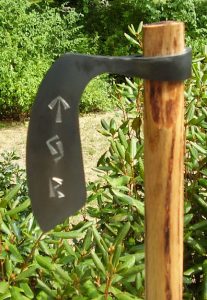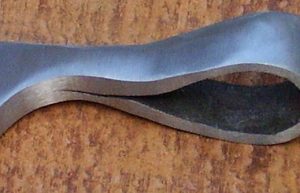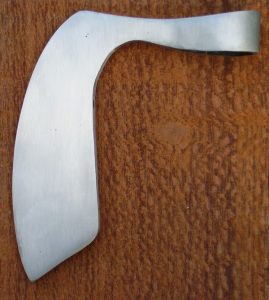 Among warrior cultures, the Norsemen created one of the richest selections of battle-tested and war-dedicated weaponry ever seen in a single culture. Spears, bows, seax, langseax, long swords, broadswords, short swords, and of course, axes. While an axe can be a tool, the Vikings clearly distinguished between axes used as common tools and those used for war. And among the Danish axe, great axe, throwing axes, and Mammen axe, the bearded axe stands out as being uniquely Norse.
Among warrior cultures, the Norsemen created one of the richest selections of battle-tested and war-dedicated weaponry ever seen in a single culture. Spears, bows, seax, langseax, long swords, broadswords, short swords, and of course, axes. While an axe can be a tool, the Vikings clearly distinguished between axes used as common tools and those used for war. And among the Danish axe, great axe, throwing axes, and Mammen axe, the bearded axe stands out as being uniquely Norse.
Made from steel and ranging in size from 1–6 lb. with hardwood hafts from 1–6 ft., the distinguishing characteristic of the weapon is the “beard” itself. The beard is simply a portion of the blade that extends down from the main blade, resulting in both a longer cutting surface and a “hook.”
Larger versions were used without a shield; smaller ones were paired with a shield or dual-wielded with a second axe or a sword. Dual-wielding was a favorite tactic of berserkers, whose approach to defense was unending and brutal offense.
Those designed as weapons are larger and heavier, and that beard offers a crucial advantage, aside from a longer cutting edge. Here’s when the hook comes into lethal play…
Axe Beard as Lethal Weapon
When the axe is thrust or swung over or around a shield and then pulled back, the hook catches the shield—and the shield can either be pulled from the opponent’s grasp or at least momentarily pulled down or aside. Either scenario is extremely dangerous for the opponent because the next thing coming is the percussive, head-splitting chop of a second axe, a chest-piercing sword thrust, or the face-crushing edge of a shield—and there’s nothing in the way to stop it.
The hook can also sweep or trip. Tripping is straightforward, but a defender can also be hooked behind the neck, shoulder, torso, or arm to pull the opponent in so he can be introduced more formally to the second weapon and the Norseman wielding it. The Norse were, after all, always interested in travelling the world, meeting new people, and killing them.
The axe requires less skill than a spear or a sword. While a neophyte can pick up an axe and fight fairly effectively with it, greater skill yields greater mayhem and carnage.
 Making a Bearded Axe
Making a Bearded Axe
From the bladesmith’s perspective, the axe requires less skill and effort to forge than a sword. While the Vikings have a steel making and smithing history equivalent to the Japanese, nonetheless, steel was a precious commodity, and the axe allowed for the very best steel to be reserved for sword making.
A smith may use several methods to forge a bearded axe. One of the simplest is to heat a flat steel bar to welding temperature, fold it in half over itself, and forge weld the flats together. A loop or “eye” is left open to accommodate the haft. The welded bar is then forged downward to form the bearded blade, and the smith forges in bevels to form the edge.
The smith then heats the whole piece to critical temperature, about 1420 ̊ F for most steel, and quenches it in water, brine, or oil to harden it. The quenched steel is very hard and quite brittle, so it needs to be tempered or “drawn back.” A smith tempers it by heating the axe again, but only to about 300–500 ͦ F, depending on the hardness desired.
 A Newly-Made Axe
A Newly-Made Axe
The accompanying pictures show a bearded axe I forged. The general construction technique can be seen, and the weld can be seen disappearing as it moves away from the eye until the two pieces of steel become one.
The example shown has an exceptionally long beard with an unusually narrow section of steel backing the blade. While fully functional, these traits clearly make it a fantasy piece rather than a historically accurate one.
Real Steel is Kobold Quarterly’s new series on historical and fantasy weapons, how they are made and how they are used. Todd Gdula is a professional bladesmith and will be writing up examples of his work frequently on this site.
If you have a particular question about real weapon-making—or a weapon you’d like to see discussed—please post it in the comments!

Coolness!
This is really great, but some pictures of the blade cutting into wood, melons, flesh would be even cooler :-)
Maybe I’ve watched deadliest warrior too much?
Serious question: how do you prevent the axe’s eye from slipping from the haft of the weapon?
Nail, rope or glue?
The obvious blade I’d like to see covered in this series is the Samurai’s “katana” – separating the myths from the reality.
Super Stuff Todd! I like the depth of analysis in this article.
Maybe someone should take a run at generating stats for the weapons as they come out. Perhaps here in the comments.
Darkjoy – I’ll try to incorporate some action or aftermath pictures in future pieces. Great idea!
The haft on this axe is held in place by pressure. The top of the haft is split and a hardwood wedge is driven into the split, making the top of the haft wider than the part in the eye. It makes for a very secure fitting and is usually all that is needed.
Acrobatic Flea – I hear you and I plan to do a piece on the katana. Before I cover the sword itself I’ll be doing something on steel and some facts and myths that will be along the lines of what you’re looking for.
Ask a Shoanti – Thank you! If anyone needs any data on weapon size and weight when they’re generating those stats feel free to ask.
Excellent, if you hang out with Kobolds long enough you just might learn something. Did Northern Europeans utilize folded steel or the Damascus process? I can’t really find any rererences?
Kobold Gold once again!
I agree stats would be nice, but I also just like this type of article for nothing more than knowledge and maybe game flavor.
This is a GREAT artice! It tickles both the recreationist and gamer in me.
OGL Stats for Bearded Axe: Everything’s the same as a battle ax, except:
1d6 damage
+2 chance to trip or disarm an opponent
bearded axe can be dropped to avoid failed trip or disarm attempt
Tom Allman – Good question. What to call the various processes for making forge folded steel can get a little squirrely, but I’ll try to explain. In my opinion the term Damascus is best used to descrbe modern pattern welded steel. It’s made by forming a stack of alternating layers of two or more types of steel which will react differently when etched. The stack is forge welded using a press, a power hammer, or hand hammered (yeah, that’s a LOT of work by hand). The stack is cut, folded, and welded again until the desired layer count is reached. The blade is then forged, and after the final grinding / polishing is subjected to an etch, usually in ferric chloride. Depending on the chemistry of the steel it will etch dark or remain bright yielding a light/dark pattern. Norse folded blades are folded, cut, and welded, but were usually made from a single steel or steel layered with iron. It’s still pattern welding, but not what we usually do today. I’ll try and cover this in more detail in a later article…
Curn Bounder – I’m trying to keep some game flavor along with some technical knowledge, but I’m more of a fantasy geek than a gamer, so it’s your job to steer me where you want me to go… Thanks!
thorr-kan – Thanks for the praise! Please feel free to make suggestions for future pieces.
Very cool article. Looking forward to the rest of the series!
Great article.
Any chance you having the axe blades for sale?
Mike – So am I! The Kobold’s and I are trying to plan several articles ahead, so any suggestions may have a lag in getting online, but I am definitely interested in writing about what you are most interested in.
Wicht – I am currently taking orders. Please email me directly at todd(at)toddblades(dot)com and we can talk.
Emails sent Todd.
That is an incredible article and look forward to many many more!
Todd, this is an excellent and informative article. I knew you could make blades, but I wasn’t aware of this level of literacy to go along with the craftsmanship ; )
Thanks for sharing your techniques and great explanations of process and product. I’m looking forward to your next installment.
Todd – Great article, very informative…can’t wait for future installments! (and yeah, some action shots would be great!)
I’d like to see articles done on one of the most versatile weapons in D&D, the Halberd. Were there other tactics with it other than the stabby, hacky, and trippy?
Also, as a personal interest, the Trident. Was it only used for fishing and gladitorial combat? I’ve tried to buy a trident before, but could only ever find blocky, stubby pronged ones. Are the ones seen in pictures with long, curved, and sometimes barbed outside prongs purely fantasy?
How about a piece on the viability of some of the fantasy racial weapons from the games we create for? Orc double ax, gnomish hook hammer, dwarven greatax, elven thinblade?
The axe pictured above has it’s edge curve outward. Is it a specific style to have the blade angle sharply down and in? Do wavy blades do more damage? Depending on armor, once the weapon (any) goes in, how difficult is it to get it out?
I had to post this article to my Society for Creative Anachronism friends, claiming “Someone just dipped SCAdian stuff in my Fantasy Role-playing.” Great article tho!
kunger00 (Keith Unger) – Thanks!
Steven Gdula – Thanks, Bro! But this doesn’t make up for the time you used my Asian coin collection to buy gum balls and rubber spiders!
Mongo – Thanks!
DoomedPaladin – The halberd is now on the list. It’s actually not a weapon I’m that familiar with, so I’m looking forward to doing some research.
As for the trident, it’s unusual to find references to it outside of gladiatorial combat, and the ones used for fishing are much smaller – usually not much more than a three pronged gig and not even made of metal in most cases. Tridents are used in traditional Chinese martial arts, especially Hung Gar Kung Fu. They are called Tiger Forks and Ox Head Forks. Do a quick search on those terms and see what you find. I believe that there is some archaeological evidence for Roman tridents with curved prongs and barbs. The problem with a curve is that it hampers efficient penetration, and a barb could cause the weapon to get stuck – very exciting in the arena, not so good on the battlefield.
Email me at todd(at)toddblades(dot)com with specifics on the fantasy racial weapons and I’ll try to find historical analogs. I think you may be surprised at how many are based on historical weapons.
As for the pictured axe, it has some extreme design elements never found in historical pieces. The beard is much longer and the body of the axe much thinner than would have been found in the real world. However, axe blades usually do curve out, and beards do curve down and in. I have seen some Chinese moon axes with edges that curve in, but I doubt their effectiveness and strength, especially against armor.
Wavy blades are a type of recurve, and recurves cut very effectively – they also look cool. They are a bear to forge and worse to grind an edge on and sharpen.
The worst armor to get something stuck in is almost certainly plate. Most swords can’t penetrate plate so it’s not an issue. Some polearms can penetrate, and the shape of the blade or prong determinse how easily it comes out. Warhammers are ideal against armor and do damage without penetrating unless they have a spike, in which case it has a steep taper so it’s easier to get out (no barb for sure). Axes are also good on armor, and some had blades shaped to avoid being stuck – either very long cutting edges or edge to body transition with shallow angles so the corner doesn’t get stuck.
Neuroglyph – Cool, SCA and RPG mix well as far as I’m concerned. Might as well throw in some LARP! We’re all geeks!
DoomedPaladin – I forgot to mention that I’d be happy to forge a custom trident – it would be fairly simple. Email me if interested: todd(at)toddblades(dot)com.
More of these…
Bardiche anyone?
Mark Arvidson – The bardiche evolved separately from the halberd but it serves some of the same functions. Is it an axe or a polearm? depends on the length of the haft. Very interesting weapon. Hmmmm… I think we’ll cover bardiche and halberd and mayhap throw in some pikes for a bristling bouquet of long stemmed blades. Spears will get a separate article because there are so many types, plus they’re one of my favorites and I get to pick. :)